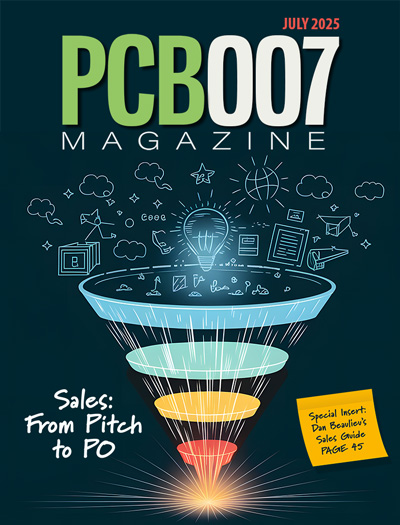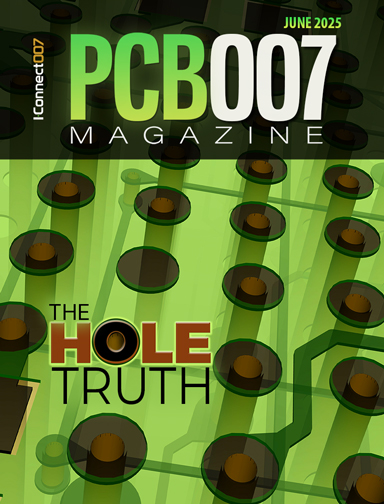-

- News
- Books
Featured Books
- pcb007 Magazine
Latest Issues
Current Issue
Inventing the Future with SEL
Two years after launching its state-of-the-art PCB facility, SEL shares lessons in vision, execution, and innovation, plus insights from industry icons and technology leaders shaping the future of PCB fabrication.

Sales: From Pitch to PO
From the first cold call to finally receiving that first purchase order, the July PCB007 Magazine breaks down some critical parts of the sales stack. To up your sales game, read on!

The Hole Truth: Via Integrity in an HDI World
From the drilled hole to registration across multiple sequential lamination cycles, to the quality of your copper plating, via reliability in an HDI world is becoming an ever-greater challenge. This month we look at “The Hole Truth,” from creating the “perfect” via to how you can assure via quality and reliability, the first time, every time.
- Articles
- Columns
- Links
- Media kit
||| MENU - pcb007 Magazine
IPC Chief Economist Dr. Shawn DuBravac Shares Industry's Financial Outlook
March 23, 2020 | I-Connect007Estimated reading time: 15 minutes
So whether we’re looking at the overall economy or even anything else—consumer spending, you name it, unemployment, and all of those will get materially worse in the second quarter. And then as we start to return to normal as businesses reopen, as we presumably have some response to this or at least, if you will, we’ve addressed the initial cause of the decline being the virus here, then you’ll start to see businesses come back, you’ll start to see consumers come back. They won’t necessarily come back to the same levels of output and consumption that they were prior to that. But because they’re coming back and because we’re measuring growth, you’ll start to see some of that recovery begin in the fourth quarter. So it depends on how you’re looking at it. Yes, we see, at least for right now, a relatively short recessionary period that will last probably from about now until the end of the third quarter or so. And then you start to see the economic recovery. But it will take some time before we return to the levels of production that we were enjoying prior to the onset of this recession.
Matties: So when you look at the current situation, what do you feel the most immediate or critical financial concern we should have in our industry?
DuBravac: Well, one of the things that we are seeing now, which is a good sign, is that the Federal Reserve is implementing a number of tools. Obviously, they cut their target interest rates early as this started to materialize into much more than just a supply shock. But they also dusted off their toolkit from the 2007 and 2009 period, and they begin to look at everything that they used then and what they could use now. And they were quick to implement some of those tools. Even this morning, the tools were expanded that they had in place. Some of these, we did not see until the eighth or ninth month of the financial crisis in 2007, 2008. Some of these were not implemented until late in 2008. And so I do see a quick response. We’re using the tools that worked well during that period.
I think those are all very good signs that remove some of the uncertainty, that we’ve seen the Fed respond very quickly, using tools that have worked in our recent past in the last recession, so that’s a good sign. What I am monitoring closely and what I talk to companies about frequently is how their lines of credit are looking. Because if you think about the lines of credit that businesses are using, often they might finance a warehouse or other equipment on any real estate, typically office buildings and in factories, warehouses tend to be financed on five-year balloons.
Every five years, they have to either refinance that loan or pay it off, and often they’re just refinancing it with the current issuer of that loan, be it a bank or someone else. What we saw during the financial crisis was that even a company that was doing well, operating fine, they were still selling product, they were able to make their payments, those loans were being called in. So when they were due at five years, they weren’t being extended. And that left businesses running to find alternative lending sources or being forced in some cases to sell this asset, sell warehouses, sell facilities. And so we watched those types of things very closely because even a company that is operating well and operating fine in this type of difficult environment could run into trouble if they have difficulties on the financing side of it.
Now a lot of what the Fed has implemented is to help address some of those things. And we haven’t heard from any companies yet that are facing these types of challenges, but I definitely am always asking about these types of things and always on the lookout for companies that might be facing any type of financial hardships as a result of this. Somebody should be checking with their bank; they should be ensuring that they have good lines of credit, that those lines of credit are secure, that they’ll be able to tap those if needed, that they’ll essentially have the liquidity that they’ll need should they run into financial constraints that are out of their control. Thus far, it looks like a lot of the manufacturers continue to operate “as normal.” And I say “as normal” in quotes.
Obviously, this is a very strong shock that we’ve seen. And from the beginning, electronics manufacturers and suppliers were impacted by this because they were having to adjust everything as new information was coming out. But at least as of last week, we were hearing from companies that they continue to operate at close to full capacity. In some instances, if they’re within the medical supply chain, they’re seeing new orders come in. Other companies report that they are ramping up production and also inventory builds just in case they run into any operating constraints or issues. For example, warehouses closing down or other things like that.
Transportation is becoming more difficult. They want to be able to turn to additional inventory that they may have on stock to be able to provides and service the sales that they have coming in.So the electronics manufacturing sector, at least for right now, seems to be intact, seems to be operating at close to full capacity here in North America. And what we’re hearing from Asia is that things have quickly come back online and by the end of the month they’ll be at or very near full capacity as well.
Matties: And if that’s any indication what’s happening in Asia, it’s kind of a model timeline for us to consider here in North America and other parts of the world.
DuBravac: I think that’s fair. I think it looks like North America and Europe, to some extent, are four to six weeks behind Asia, with respect to closures and other impacts from the spread of this virus. And so I would expect that Europe and North America would follow that similar timeline. And again, it’s never perfect. There are lots of dynamic situations that are continuing to develop and will develop over those six weeks. For example, in February, about 8% of container shipment capacity was underutilized essentially, was offline. That’s all coming back online this month and making the major container shipping companies anticipate being at full capacity in March, by the end of March. But that period in February where they weren’t at full capacity creates issues. You have the buildup of empty container cargo containers that end up building up outside of the port, or they’re left on train cars and on side rails and other things like that.Page 2 of 3
Testimonial
"In a year when every marketing dollar mattered, I chose to keep I-Connect007 in our 2025 plan. Their commitment to high-quality, insightful content aligns with Koh Young’s values and helps readers navigate a changing industry. "
Brent Fischthal - Koh YoungSuggested Items
Smartphone Production Rises 4% QoQ in 2Q25 as Inventory Adjustment Ends
09/12/2025 | TrendForceTrendForce’s latest investigations reveal that global smartphone production reached 300 million units in 2Q25, up 4% QoQ and 4.8% YoY, driven by seasonal demand and the recovery of brands such as Oppo and Transsion following inventory adjustments.
I-Connect007 Editor’s Choice: Five Must-Reads for the Week
09/12/2025 | Marcy LaRont, I-Connect007We may be post-Labor Day, but it is still hot-hot-hot here in the great state of Arizona—much like our news cycles, which have continued to snap, crackle, and pop with eye-raising headlines over this past week. In broader global tech news this week, AI and tariff-type restrictions continues to dominate with NVIDIA raising its voice against U.S. lawmakers pushing chip restrictions, ASML investing in a Dutch AI start-up company to the tune of $1.5 billion, and the UAE joining the ranks of the U.S. and China in embracing “open source” with their technology in hopes of accelerating their AI position.
Delta Electronics Posts 26.7% Growth in Sales Revenues for August
09/12/2025 | Delta ElectronicsDelta Electronics, Inc. announced its consolidated sales revenues for August 2025 totaled NT$47,860 million, a 26.7 percent increase as compared to NT$37,770 million for August 2024 and a 5.4 percent increase as compared to NT$45,397 million for July 2025.
Flex Named to TIME's World's Best Companies List for Third Consecutive Year
09/12/2025 | FlexFlex announced its inclusion on the TIME World's Best Companies 2025 list. This marks the third consecutive year the company was included in this prestigious ranking, which recognizes top-performing companies across the globe.
Direct Imaging System Market Size to Hit $4.30B by 2032, Driven by Increasing Demand for High-Precision PCB Manufacturing
09/11/2025 | Globe NewswireAccording to the SNS Insider, “The Direct Imaging System Market size was valued at $2.21 Billion in 2024 and is projected to reach $4.30 Billion by 2032, growing at a CAGR of 8.68% during 2025-2032.”


